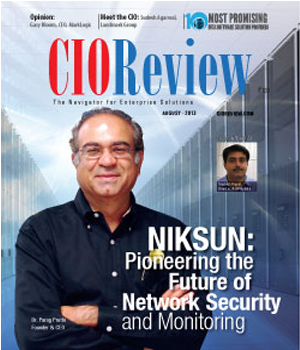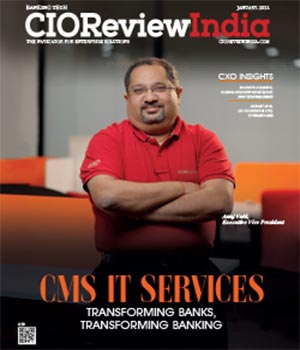
Optimizing Resources and Storage Space in the Private Cloud
Shrikant Kulkarni, CIO, KPIT Technologies Limited
 KPIT Technologies Limited (NSE: KPIT) is a product engineering and IT consulting company providing solutions and services to the Manufacturing, Automotive, Industrial Equipments, Utilities and Semiconductor companies. Headquartered in Pune, the company has a market cap of Rs 3204 crores.
KPIT Technologies Limited (NSE: KPIT) is a product engineering and IT consulting company providing solutions and services to the Manufacturing, Automotive, Industrial Equipments, Utilities and Semiconductor companies. Headquartered in Pune, the company has a market cap of Rs 3204 crores.
A confluence of cloud computing, better offerings from service providers and improved technology is making the overhaul of IT possible for the first time. Rather than hiring someone else to staff the department and maintain the applications of the average IT department, it is now possible for a fully functional corporate IT department to have a handful of staff and no real infrastructure beyond networks and end user devices. With BYOD, IT can even exit the business of maintaining end-user devices, and the CIO can exist in a purely strategic role, effectively purchasing all utility functions from another party.
For the leadership whose role majorly focuses on Technical Infrastructure, Infrastructure Systems and Security; it is important to adopt new technologies to support business and make sure that the organization is at the forefront of the industry. The team needs to be agile to go for implementations which can take business processes to the next level and help the employees produce more output from the same input. Virtual desktop infrastructure is one of the areas which have been considered too expensive in the past, but with cloud computing and an increasingly mobile workforce, traditional desktop computing consumes excessive time and resources. VDI eliminates the need to purchase multiple licenses for every employee since they have multiple devices and it is also a high margin opportunity for web hosts. Virtualized servers and desktops hold the key to more efficient IT management. Operated in a cloud environment, it facilitates the flow of information between corporate offices and increases the productivity of employees who work remotely or from mobile enterprise devices.
Private Cloud
An orientation towards private clouds can be seen today among enterprises for more than just virtual infrastructure provisioning. Private cloud vendors have started to bundle additional capabilities into their solutions, including pervasive VM management capabilities, design tools for complex application templates, and service catalogs. Enterprises are focusing on building internal private clouds and the most common approach in practice is through the purchase of commercial software to layer atop existing infrastructure resources. However, regardless of the approach being chosen, there is no shortage of tools to support the efforts. Private cloud looks promising as it helps in optimization of resources and storage space, which in turn has helped improve business because of the reduced turnaround time.
The Global IT Asset Management Software market has also been witnessing the emergence of cloud computing. However, the high deployment cost could pose a challenge to the growth of this market. Software Asset Management is still considered niche. It is a discipline that can be traced back to the creation of licensing but in the grand scale of things it is very much in its infancy, especially in terms of adoption. There is also market confusion over what constitutes a SAM tool. Many vendors position themselves as having SAM functionality whereas; in reality it is systems management or inventory. With the maturing market and the growth in practice of IT Asset Management as a business discipline, this difference is becoming more apparent and a lot of investment can be seen in automated processes to bring IT assets in place.
The Infrastructure Security Domain
Modern IT departments are currently facing a fundamental shift in security practices. Applications are moving to the web. Employees are using their own mobile devices. Cloud-based, consumer applications are creeping into the business. The challenge of securing devices and data that are increasingly beyond their control is something that CIOs and IT leaders are struggling with. One of the biggest challenges is to get funding for the various initiatives undertaken by the CIO. Funding comes only when the CIO team can convince the management that the initiatives can help the business. It is followed by the responsibility of encouraging the team to accept new technology initiatives, as the workforce is sometimes reluctant to adopt new technologies, being too comfortable with the technologies that they have been using.
The CIOs need to focus on how a technology or a function is going to add value to the business. They need to help employees become more productive with the adoption of new technologies, as they are the majority stake in a company. Getting management support for initiatives also holds importance as their commitment is required for implementation of the same in the company. With focus on the launch of initiatives and getting maximum benefits out of them, CIOs are looking to leverage BYOD and see how it can boost the productivity of employees. Another segment which is attracting the attention of CIOs is Infrastructure Security domain which requires a lot of work to be done on data leakage prevention and Rights Management through methods like strengthening of the firewall system to avoid confidential information being circulated apart from the concerned group. Cost effective tools for ERP and Big Data domains also need to be devised keeping in mind the specific needs of small and large enterprises. (As told to Sudhakar Singh)
CIO Viewpoint
Why Foolproof Facial Recognition Is Key Against...
By Joseph Sudheer Thumma, Global CEO & MD, Magellanic Cloud
National Technology Day 2025: Powering Progress...
By CIOTech Outlook Team
Aligning IT Roadmap with Business Objectives: A...
By Subhash singh Punjabi, CISO & Head Enterprise Architecture, Deepak Fertilisers & Petrochemicals Corporation Ltd
CXO Insights
Revolutionizing BFSI: The Impact of AI and ML...
By Mike Yesudas, CTO, SunTec Business Solutions
Bridging the Gap: No-Code Platforms and...
By Mr. Muzammil Patel, Global Head Strategy and Corporate Finance at Acies
The Impact of Custom Software on the Indian...



.jpg)



